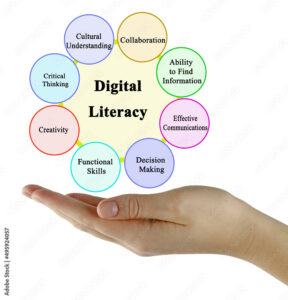Fight the fake news with Digital literacy !!
In today’s world the proper teaching and development of information literacy has never been more important when it comes to students’ success in comprehending the masses of information they come across on a daily basis. In the context of my subject matter, I would teach my students how to negotiate, interpret and evaluate content, and also how to determine prejudice and check facts. That way, students are encouraged to practice these skills at the curriculum level to learn how the information influences their perceptions or the world.
My subject Area and Integrating Digital Literacy Instruction Credibility with support From Caulfield’s “Web Literacy for Student Fact-Checkers,” I would teach my students techniques like lateral reading, which is the ability to verify information using other reliable sources. In social studies after reading different articles, according to student’s ability they can make a conclusion about the article’s source, figuring out if it is reliable or not. Building on the “7 Types of Mis- and Dis-Information” framework by Claire Wardle students would be introduced to real examples of misinformation. In English, it can entail things such as: reading articles about persuasion; learning about clickbait, and knowing its purpose. In the article “How Educators Can Counter Fake News with Information Literacy”, I would like students, as a class, to discuss the nature of headlines and media presentation of information. For example, they could do an activity that involved evaluation of news coverage of the same event on different platforms, so that they learn how to understand framing and language used in coverage.
General ties I can make to the curriculum are:
- English Language Arts: How text structure works, viewing perspectives, and assessing arguments.
- Social Studies: Historical representation, civic culture, and democracy.
- Science: Being able to understand truth and reasoning it’s that also to support opinions and/or responses, especially in case of evaluating scientific data and differ between fact and fake news.
To incorporate the goals of NCTE framework I can do the following:
- Students should be taught how to identify where information comes from and what its goal is.
- A last way is to get the students ponder about how they are gaining their knowledge from what they are consuming, specifically with regards media.
- Enable students to make presentations that discuss their discoveries for ethical and responsible engagement.
Teaching digital literacy is not limited to explaining what fake news is – it is about training people to be good citizens in the era of digital media. Combining ideas from Mike Caulfield’s fact-checking techniques, Claire Wardle’s misinformation taxonomy, and ‘The Smell Test’ prepare students as critical thinkers and sensible engaging actors in the digital world.
Resources:
- Web Literacy for Student Fact-Checkers by Mike Caulfield
- 7 Types of Mis- and Dis-Information” by Claire Wardle
- The Smell Test: Educators Can Counter Fake News with Information Literacy

